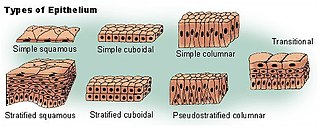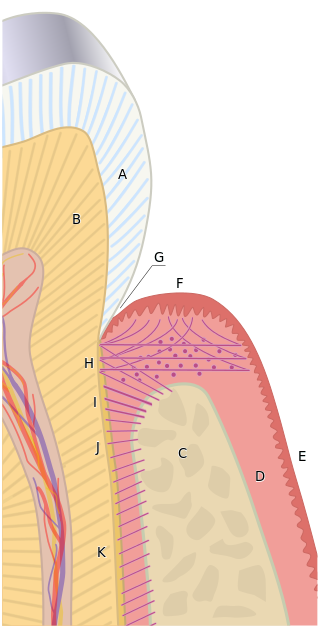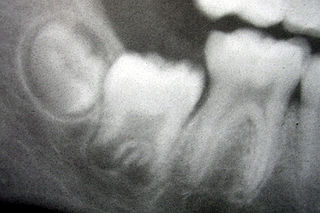Related Research Articles

Epithelium or epithelial tissue is one of the four basic types of animal tissue, along with connective tissue, muscle tissue and nervous tissue. It is a thin, continuous, protective layer of compactly packed cells with a little intercellular matrix. Epithelial tissues line the outer surfaces of organs and blood vessels throughout the body, as well as the inner surfaces of cavities in many internal organs. An example is the epidermis, the outermost layer of the skin.

Cementum is a specialized calcified substance covering the root of a tooth. The cementum is the part of the periodontium that attaches the teeth to the alveolar bone by anchoring the periodontal ligament.

Tooth enamel is one of the four major tissues that make up the tooth in humans and many other animals, including some species of fish. It makes up the normally visible part of the tooth, covering the crown. The other major tissues are dentin, cementum, and dental pulp. It is a very hard, white to off-white, highly mineralised substance that acts as a barrier to protect the tooth but can become susceptible to degradation, especially by acids from food and drink. Calcium hardens the tooth enamel. In rare circumstances enamel fails to form, leaving the underlying dentin exposed on the surface.

Dentin or dentine is a calcified tissue of the body and, along with enamel, cementum, and pulp, is one of the four major components of teeth. It is usually covered by enamel on the crown and cementum on the root and surrounds the entire pulp. By volume, 45% of dentin consists of the mineral hydroxyapatite, 33% is organic material, and 22% is water. Yellow in appearance, it greatly affects the color of a tooth due to the translucency of enamel. Dentin, which is less mineralized and less brittle than enamel, is necessary for the support of enamel. Dentin rates approximately 3 on the Mohs scale of mineral hardness. There are two main characteristics which distinguish dentin from enamel: firstly, dentin forms throughout life; secondly, dentin is sensitive and can become hypersensitive to changes in temperature due to the sensory function of odontoblasts, especially when enamel recedes and dentin channels become exposed.
Tomes's processes are a histologic landmark identified on an ameloblast, cells involved in the production of tooth enamel. During the synthesis of enamel, the ameloblast moves away from the enamel, forming a projection surrounded by the developing enamel. Tomes's processes are those projections and give the ameloblast a "picket-fence" appearance under a microscope.
Interrod enamel is histologically identified on microscopic views of tooth enamel. Because interrod enamel is located around enamel rods, the areas of interrod enamel enhances the "keyhole" appearance of enamel rods by acting as its border. The location where the two areas of enamel meet is known as the rod sheath.

Tooth development or odontogenesis is the complex process by which teeth form from embryonic cells, grow, and erupt into the mouth. For human teeth to have a healthy oral environment, all parts of the tooth must develop during appropriate stages of fetal development. Primary (baby) teeth start to form between the sixth and eighth week of prenatal development, and permanent teeth begin to form in the twentieth week. If teeth do not start to develop at or near these times, they will not develop at all, resulting in hypodontia or anodontia.

In embryology and prenatal development, the dental papilla is a condensation of ectomesenchymal cells called odontoblasts, seen in histologic sections of a developing tooth. It lies below a cellular aggregation known as the enamel organ. The dental papilla appears after 8–10 weeks intra uteral life. The dental papilla gives rise to the dentin and pulp of a tooth.
Rod sheath is an area identified in histologic sections of a tooth. It is found where enamel rods, the functional unit of enamel, meet interrod enamel. The crystals of both types of enamel meet at sharp angles and form the appearance of a space called the rod sheath. As a result of this space, the rod sheath consists of more protein than other areas of enamel. For this reason, the rod sheath is characterized as being hypomineralized in comparison to the rest of the highly mineralized enamel.
Gnarled enamel is a description of enamel seen in histologic sections of a tooth underneath a cusp. This is optical appearance of enamel. The enamel appears different and very complex under the cusp, but this is not due to a different arrangement of dental tissues. Instead, the enamel still has the same arrangement of enamel rods. The strange appearance results from the lines of enamel rods directed vertically under a cusp and from their orientation in a small circumference.

The outer enamel epithelium, also known as the external enamel epithelium, is a layer of cuboidal cells located on the periphery of the enamel organ in a developing tooth. This layer is first seen during the bell stage.

The inner enamel epithelium, also known as the internal enamel epithelium, is a layer of columnar cells located on the rim nearest the dental papilla of the enamel organ in a developing tooth. This layer is first seen during the cap stage, in which these inner enamel epithelium cells are pre-ameloblast cells. These will differentiate into Ameloblasts which are responsible for secretion of enamel during tooth development.

The cervical loop is the location on an enamel organ in a developing tooth where the outer enamel epithelium and the inner enamel epithelium join. The cervical loop is a histologic term indicating a specific epithelial structure at the apical side of the tooth germ, consisting of loosely aggregated stellate reticulum in the center surrounded by stratum intermedium. These tissues are enveloped by a basal layer of epithelium known on the outside of the tooth as outer enamel epithelium and on the inside as inner enamel epithelium. During root formation the inner layers of epithelium disappear and only the basal layers are left creating Hertwig's epithelial root sheath (HERS). At this point it is usually referred to as HERS instead of the cervical loop to indicate the structural difference.
In tooth development, the enamel knot is a localization of cells on an enamel organ that appear thickened in the center of the inner enamel epithelium. The enamel knot is frequently associated with an enamel cord. It is formed in the cap stage and undergoes apoptosis in the bell stage.

The stellate reticulum is a group of cells located in the center of the enamel organ of a developing tooth. These cells are star-shaped and synthesize glycosaminoglycans. As glycosaminoglycans are produced, water is drawn in between the cells, stretching them apart. As they are moved further away from one another, the stellate reticular cells maintain contact with one another through desmosomes, resulting in their unique appearance. The stellate reticulum is lost after the first layer of enamel is laid down. This brings cells in the inner enamel epithelium closer to blood vessels at the periphery.
The stratum intermedium in a developing tooth is a layer of two or three cells between the inner enamel epithelium and the newly forming cells of the stellate reticulum. It first appears during the early bell stage of tooth development, at around the 14th week of intrauterine life. These cells are closely attached by desmosomes and gap junctions .The stratum intermedium has a notably high alkaline phosphatase activity. This layer, along with the inner enamel epithelium, is responsible for the tooth enamel formation. It is a part of the dental (enamel) organ. Stratum intermedium stores glycogen. It is absent in the part of the tooth germ that outlines the root portions of the tooth which does not form enamel.
The reduced enamel epithelium, sometimes called reduced dental epithelium, overlies a developing tooth and is formed by two layers: a layer of ameloblast cells and the adjacent layer of cuboidal cells from the dental lamina. As the cells of the reduced enamel epithelium degenerate, the tooth is revealed progressively with its eruption into the mouth. The degeneration of reduced enamel epithelium also mediates the initial epithelial attachment to the tooth, which is called the junctional epithelium.
The enamel niche is a structure that appears in a histologic slide of a developing tooth from sectioning the slide in a single plane. The enamel organ looks to be connected to the oral epithelium by two or more strands of dental lamina. The enamel niche is the name of the mesenchymal cells which look to be surrounded by the strands of the dental lamina. In actuality, there is no mesenchyme completely surrounded by dental lamina. This appearance is due to a funnel shaped depression of the dental lamina. These cases are a result from the dental lamina being a curved structure while the slide contains tissue taken in one plane.
Dental anatomy is a field of anatomy dedicated to the study of human tooth structures. The development, appearance, and classification of teeth fall within its purview. Tooth formation begins before birth, and the teeth's eventual morphology is dictated during this time. Dental anatomy is also a taxonomical science: it is concerned with the naming of teeth and the structures of which they are made, this information serving a practical purpose in dental treatment.
Hard tissue, refers to "normal" calcified tissue, is the tissue which is mineralized and has a firm intercellular matrix. The hard tissues of humans are bone, tooth enamel, dentin, and cementum. The term is in contrast to soft tissue.
References
- Ross, Michael H.; Gordon I. Kaye; Wojciech Pawlina (2003). Histology: A Text and Atlas (4th ed.). Philadelphia, Pa.: Lippincott Williams & Wilkins. ISBN 0-683-30242-6.
- Ten Cate, Richard (1998). Oral Histology: Development, Structure, and Function (5th ed.). St. Louis, Mo.: Mosby. ISBN 0-8151-2952-1.